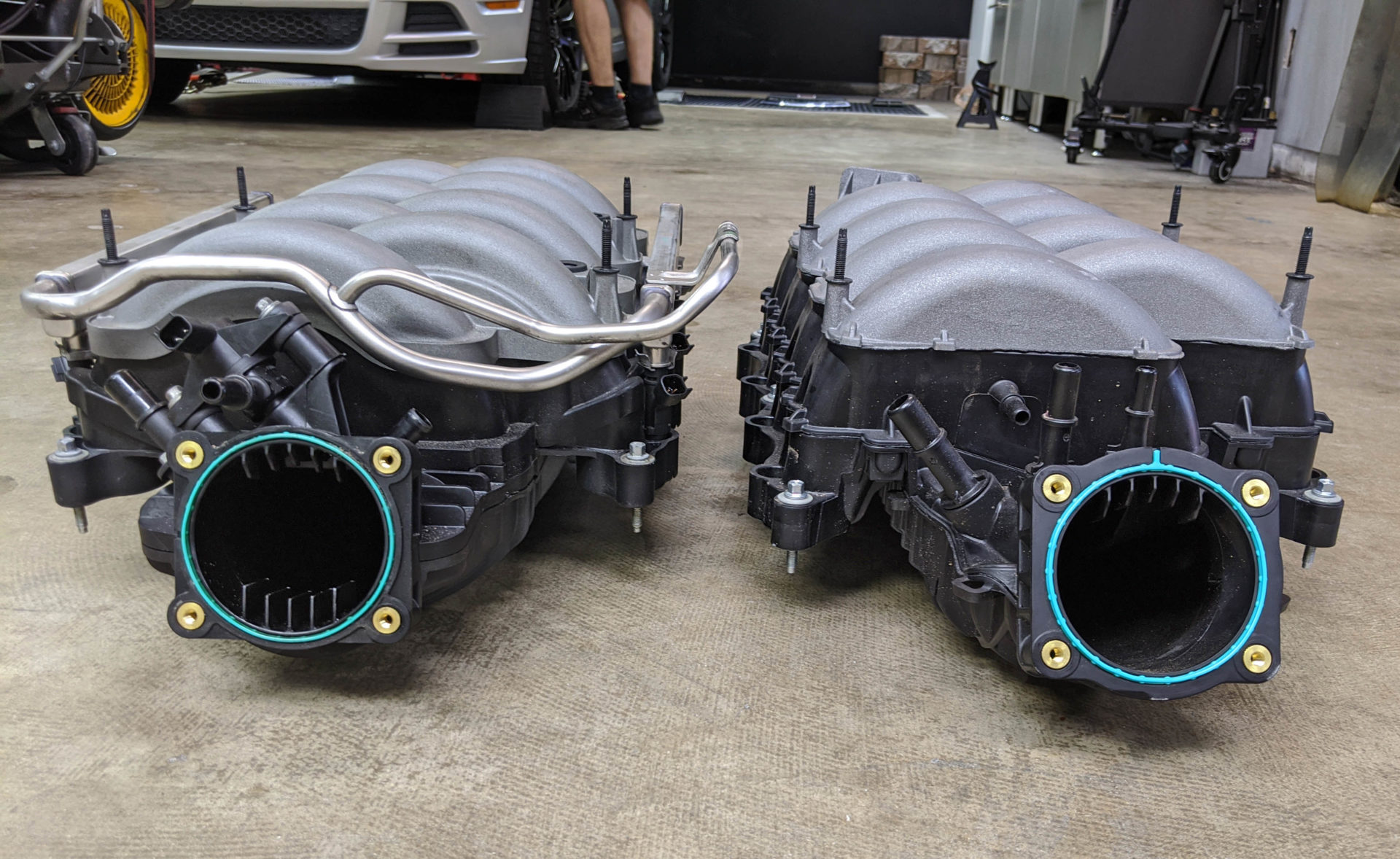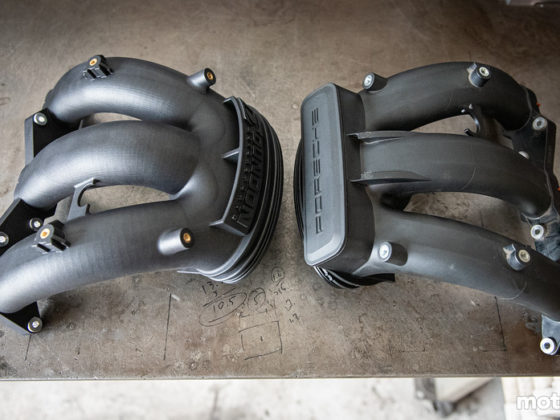
With the carbon fiber airbox lid on, we were ready to make our next pull.
Stock 2014 Mustang GT VS K&N Intake No Tune

The K&N “RACE” Performance Air Intake System increased peak power by 7.47 HP at 6,700 RPM and a peak torque increase of 7.06 LB-FT at 4,300 RPM. There’s a nice 5 HP average increase from 3,900-5,600 RPM, right in the middle of the rev range but we lost a little below 3,500 RPM.
Overall, this wasn’t the most power increase we’ve seen from K&N, but it was pretty good given that we didn’t tune it other than a quick and simple airflow scaling change. There would likely have been greater gains from tuning this intake system over a stock tuned car.
We are now less than 12 WHP away from our 400 WHP target. Next up we are going to put a 2018+ (Gen-3) Mustang intake manifold on our Gen-1 to see what happens.

The 2018+ Mustang intake manifold took what was learned from the 8,250 RPM Shelby GT350 intake manifold, and tuned it for the 7,500 RPM (Gen-3) Coyote, giving it a broader torque curve for street use. This manifold is an extremely popular upgrade for the 2015-2017 (Gen-2) Mustang GTs, which see pretty impressive gains from the swap.
We tested Ford’s Power Packs 1-3, including their “PP3” that uses the GT350 intake manifold. Due to the significantly lower cost, and the fact that most Gen-2 Coyotes don’t rev over 8,000 RPM, the 2018+ manifold is a far more popular choice.
The most common upgrade for the Gen-1 S197 cars is the high-rise BOSS 302 intake manifold. This was designed for the S197 BOSS 302, and it’s proven to be a great performer. To shake things up a little and retain a stock look, we decided to be one of the few people to post dyno results of a 2018+ manifold on a Gen-1.

Before installing the 2018+ intake manifold, we have to delete the factory Charge Motion Control Valves (CMCV) since our old Gen-1 is not equipped to control them.
Quick Reference:
Page 1 – Baseline Dyno
Page 2 – K&N Performance Air Intake System
Page 3 – K&N Intake Install
Page 4 – K&N Intake Dyno & 2018+ Intake Manifold
Page 5 – 2018+ Intake Manifold CMCV Delete and Stock Manifold Removal
Page 6 – Stock Gen 1 vs Gen 3 (2018+) Manifold Comparison
Page 7 – 2018+ Manifold Install
Page 8 – 2018+ Manifold Dyno & Tune




10 comments
Would it make sense to attempt a bit of port matching to accommodate for the larger ports on the manifold. It doesn’t appear to be a huge difference, but hitting that hard edge on the heads is definitely disturbing air flow.
I guess the big unanswered question is would the same tune time get you 400hp with the old manifold minus the torque loss. Doubt you would get a peak that matches, but the area under the curve might be more useful on a track car.
Stay tuned for Part 3 where we answer that question.
and here I was all excited to read about panhard bar benefits over watts link…
Stay tuned for the article that tackles the suspension.
Love it.
Awesome testing! Based on what I saw on Project S2000 with testing of the airbox lid on vs off, I mean, you and I know you’ll see similar on the Mustang. But it’s always great to see the real data, so I’m excited to see it! I always love seeing the data you present.
As much of a Mustang fan as I am, certainly a 4th gen F-body with a cam and exhaust is a cheaper ticket to 400whp.
I just looked into it and it doesn’t seem like a cam and exhaust can make 400whp on an F-body. Even if it does, this is “Budget 400whp TRACK CAR” and it would cost far more to make an F-body competent on road courses 😉
Great information,I can’t wait to see the third article.